不带to的动词不定式通常有下面十八种情况
不定式什么时候不带to
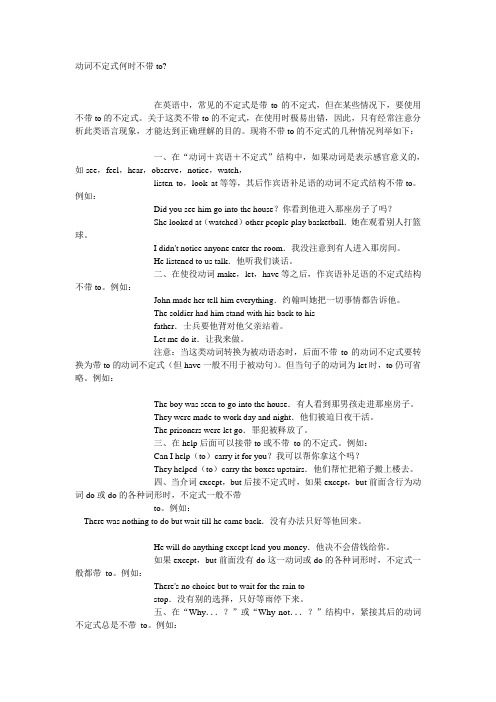
动词不定式何时不带to?在英语中,常见的不定式是带to的不定式,但在某些情况下,要使用不带to的不定式。
关于这类不带to的不定式,在使用时极易出错,因此,只有经常注意分析此类语言现象,才能达到正确理解的目的。
现将不带to的不定式的几种情况列举如下:一、在“动词+宾语+不定式”结构中,如果动词是表示感官意义的,如see,feel,hear,observe,notice,watch,listen to,look at等等,其后作宾语补足语的动词不定式结构不带to。
例如:Did you see him go into the house?你看到他进入那座房子了吗?She looked at(watched)other people play basketball.她在观看别人打篮球。
I didn't notice anyone enter the room.我没注意到有人进入那房间。
He listened to us talk.他听我们谈话。
二、在使役动词make,let,have等之后,作宾语补足语的不定式结构不带to。
例如:John made her tell him everything.约翰叫她把一切事情都告诉他。
The soldier had him stand with his back to hisfather.士兵要他背对他父亲站着。
Let me do it.让我来做。
注意:当这类动词转换为被动语态时,后面不带to的动词不定式要转换为带to的动词不定式(但have一般不用于被动句)。
但当句子的动词为let时,to仍可省略。
例如:The boy was seen to go into the house.有人看到那男孩走进那座房子。
They were made to work day and night.他们被迫日夜干活。
The prisoners were let go.罪犯被释放了。
不带to的不定式
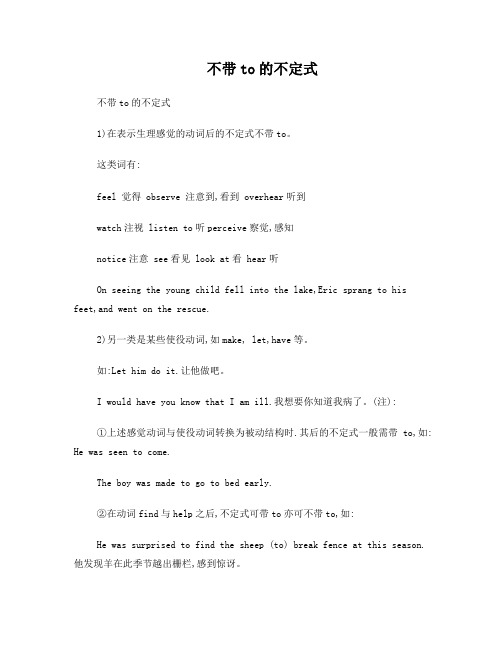
不带to的不定式不带to的不定式1)在表示生理感觉的动词后的不定式不带to。
这类词有:feel 觉得 observe 注意到,看到 overhear听到watch注视 listen to听perceive察觉,感知notice注意 see看见 look at看 hear听On seeing the young child fell into the lake,Eric sprang to his feet,and went on the rescue.2)另一类是某些使役动词,如make, let,have等。
如:Let him do it.让他做吧。
I would have you know that I am ill.我想要你知道我病了。
(注):①上述感觉动词与使役动词转换为被动结构时.其后的不定式一般需带to,如: He was seen to come.The boy was made to go to bed early.②在动词find与help之后,不定式可带to亦可不带to,如:He was surprised to find the sheep (to) break fence at this season.他发现羊在此季节越出栅栏,感到惊讶。
3)在do nothing/anything/everything but(except)结构中。
例如:Last night I did nothing but watch TV.昨天晚上,我除了看电视别的什么也没有干。
但是,如果谓语动词不是“do nothing,anything,everything”,那么but(except)所跟的不定式则仍须带。
The doctor told him nothing but to stop smoking.医生除了让他戒烟,其它什么都没有说。
There was nothing for them to do but to remain silent.除了保持沉默以外,他们没有别有别的办法。
不带to的动词不定式通常有下面十八种情况

(1)We found the farm crops(to) do well.
(2)I find the Chinese people to be happy and cheerful.
(8)I had sooner live on a farm than in the city.
(9)He would sooner resign than take part in such dishonest business deeds.
(8)He observed someone open the door.
(9)I did not perceive anyone come in.
(10)He beheld her go out.
(5)Could you do something for me?
(6)You shall go at once.
(7)He might be working in the office now.
(4)I heard her play the piano.
(5)He listend to us talk.
(6)I felt the floor move.
(7)I didn’t notice you enter.
不带to的动词不定式通常有下面十八种情况.txt今天心情不好。我只有四句话想说。包括这句和前面的两句。我的话说完了对付凶恶的人,就要比他更凶恶;对付卑鄙的人,就要比他更卑鄙没有情人味,哪来人情味 拿什么整死你,我的爱人。收银员说:没零钱了,找你两个塑料袋吧! 不带to的动词不定式通常有下面十八种情况
不带to的动词不定式
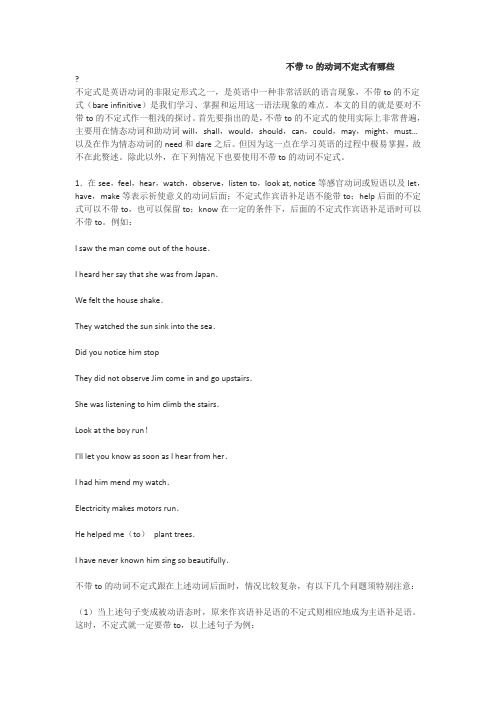
不带to的动词不定式有哪些?不定式是英语动词的非限定形式之一,是英语中一种非常活跃的语言现象,不带to的不定式(bare infinitive)是我们学习、掌握和运用这一语法现象的难点。
本文的目的就是要对不带to的不定式作一粗浅的探讨。
首先要指出的是,不带to的不定式的使用实际上非常普遍,主要用在情态动词和助动词will,shall,would,should,can,could,may,might,must…以及在作为情态动词的need和dare之后。
但因为这一点在学习英语的过程中极易掌握,故不在此赘述。
除此以外,在下列情况下也要使用不带to的动词不定式。
1.在see,feel,hear,watch,observe,listen to,look at, notice等感官动词或短语以及let,have,make等表示祈使意义的动词后面;不定式作宾语补足语不能带to;help后面的不定式可以不带to,也可以保留to;know在一定的条件下,后面的不定式作宾语补足语时可以不带to。
例如:I saw the man come out of the house.I heard her say that she was from Japan.We felt the house shake.They watched the sun sink into the sea.Did you notice him stopThey did not observe Jim come in and go upstairs.She was listening to him climb the stairs.Look at the boy run!I'll let you know as soon as I hear from her.I had him mend my watch.Electricity makes motors run.He helped me(to)plant trees.I have never known him sing so beautifully.不带to的动词不定式跟在上述动词后面时,情况比较复杂,有以下几个问题须特别注意:(1)当上述句子变成被动语态时,原来作宾语补足语的不定式则相应地成为主语补足语。
英语语法:不带to的不定式

英语语法:不带to的不定式 英语动词有三个⾮限定形式,即不定式、-ing分词和-ed分词。
关于不定式,⼩编想告诉你:不定式分为两种——带to不定式和不带to不定式。
我们从⼩就⽿熟能详的to do 不定式,竟然会不带to?!这到底是怎么回事?在哪些场合不定式不带to呢?请听⼩编细细为⼤家讲解: 1. 在情态动词后:情态动词后⽤不带to的不定式。
You must study hard. 你必须好好学习。
You should finish it as soon as possible. 你应该尽快完成这件事。
注:边际情态动词有所不同。
如need作情态动词时,跟不带to不定式;作主动词后跟带to不定式。
We need stay at home this morning. (作情态动词)我们今晚要待在家⾥。
We need to stay at home this morning. (作主动词)我们今晚要待在家⾥。
2. 在半助动词后: You had better bring an umbrella with you when you go out. 你出门最好带⼀把伞。
3. 在情态成语后: 在would rather/ would sooner/ would as soon, may/ might as well, cannot but/ cannot help but等情态成语之后,跟不带to不定式。
I would rather not know you. 我宁愿不认识你。
We might as well take a walk since it is sunny now. 天⽓晴朗,我们不妨⾛⾛。
4. 在rather than和sooner than(置于句⾸)后: Rather than cause trouble,he left his hometown. 他宁愿离开家乡也不愿引起⿇烦。
动词不定式专题:不带to不定式的十八种情况

不带to不定式的十八种情况动词不定式通常带有符号to,叫做带to的动词不定式(infinitive with "to"),动词不定式有时不带符号to,叫做不带to的动词不定式(infinitive without "to")不带to的动词不定式通常有下面十八种情况:一、与助动词do连用构成谓语动词的否定、疑问和强调形式。
(1)He does not work in the factory.他不在这家工厂上班。
(2)Does she work here?她在这儿上班吗?(3)I did not see her yesterday.我昨天没有看见她。
(4)Did they take you home?他们把你送回家了吗?(5)He does look tired.他看上去的确累了。
(6)They did come yesterday.他们昨天确实来了。
二、与情态动词连用构成复合谓语(1)I can speak English.我会说英语。
(2)May I come in?我能进来吗?(3)Dare he swim across the river? 他敢游过这条河吗?(4)We must work, and above all we must believe in ourselves.我们必须工作,首先我们要信得过自己。
(5)Could you do something for me? 你能为我做点事吗?(6)You shall go at once.你得马上走。
(7)He might be working in the office now. 他这会儿可能正在上班。
(8)I don't think you need have come yesterday. 我觉得你昨天没必要来。
(9)They should be here by now. 他们这会儿应该到了。
不带to的动词不定式通常有下面十八种情况

不带to的动词不定式通常有下面十八种情况动词不定式通常带有符号to,叫做带to的动词不定式(infinitive with"to"),动词不定式有时不带符号to,叫做不带to的动词不定式不带to的动词不定式通常有下面十八种情况一、与助动词do连用构成谓语动词的否定、疑问和强调形式。
(1)he does not work in the factory.(2)Does she work here?(4)Did they(6)They did come二、与情态动词连用构成复合谓语(3)Dare he swim across the river?(4)We must work,and(5)Could you do something for me?(6)You shall go(7)He might be working in the office now.(8)I don't think you need have come yesterday.(9)They should be here by now.(10)If you will go into the fields and turn over a few big stones,you are sure to uncover a city of但与情态动词ought(to)连用时通常带to,和used(to)连用时必须带三、在表示感觉的动词如:see,look.at,watch,hear,listento,feel,notice,observe,perceive(觉察,看见),behold(书面用语“见到”)等后用作宾语补足语的动词不定。
(2)He looked at the children walk up the hill.(4)I heard her(6)I felt the(9)I did not perceive anyone come in.(10)He beheld但除notice,watch不用被动语态外,上述动词变成被动语态时,其后的动词不定式就不省to(2)She was四、使役动词make,let,have,bid, leave(=let)后作宾语补足语的动词不定式不带(4)Bid him go home.动词have通常不用于被动语态,make和bid可用于被动语态,let偶尔也可用于被动态,用作主语补足语的动词不定式通常带to,但在make和let后有时可以不带to(2)He was made(t(3)The child五、never与know连用其后作宾语补足语的动词不定式可省to,其时态多为完成时态。
不带to的动词不定式
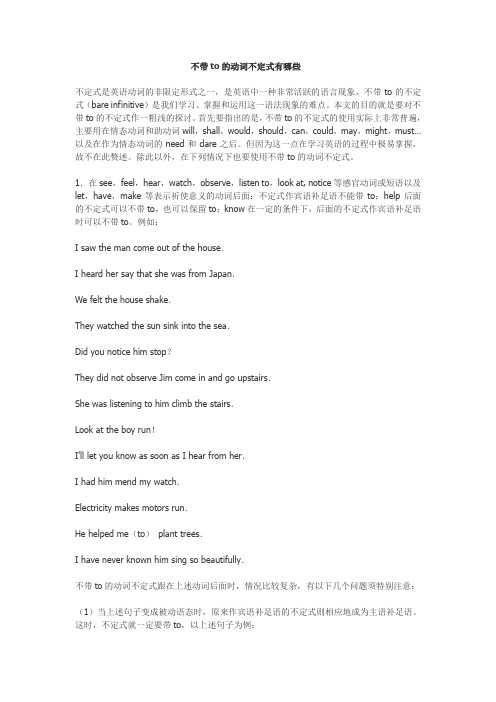
不带to的动词不定式有哪些不定式是英语动词的非限定形式之一,是英语中一种非常活跃的语言现象,不带to的不定式(bare infinitive)是我们学习、掌握和运用这一语法现象的难点。
本文的目的就是要对不带to的不定式作一粗浅的探讨。
首先要指出的是,不带to的不定式的使用实际上非常普遍,主要用在情态动词和助动词will,shall,would,should,can,could,may,might,must…以及在作为情态动词的need和dare之后。
但因为这一点在学习英语的过程中极易掌握,故不在此赘述。
除此以外,在下列情况下也要使用不带to的动词不定式。
1.在see,feel,hear,watch,observe,listen to,look at, notice等感官动词或短语以及let,have,make等表示祈使意义的动词后面;不定式作宾语补足语不能带to;help后面的不定式可以不带to,也可以保留to;know在一定的条件下,后面的不定式作宾语补足语时可以不带to。
例如:I saw the man come out of the house.I heard her say that she was from Japan.We felt the house shake.They watched the sun sink into the sea.Did you notice him stop?They did not observe Jim come in and go upstairs.She was listening to him climb the stairs.Look at the boy run!I'll let you know as soon as I hear from her.I had him mend my watch.Electricity makes motors run.He helped me(to)plant trees.I have never known him sing so beautifully.不带to的动词不定式跟在上述动词后面时,情况比较复杂,有以下几个问题须特别注意:(1)当上述句子变成被动语态时,原来作宾语补足语的不定式则相应地成为主语补足语。
巧记不带to的动词不定式
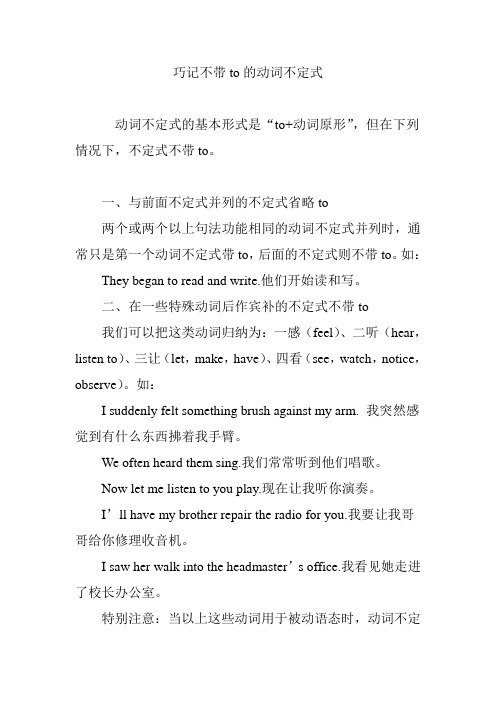
巧记不带to的动词不定式动词不定式的基本形式是“to+动词原形”,但在下列情况下,不定式不带to。
一、与前面不定式并列的不定式省略to两个或两个以上句法功能相同的动词不定式并列时,通常只是第一个动词不定式带to,后面的不定式则不带to。
如:They began to read and write.他们开始读和写。
二、在一些特殊动词后作宾补的不定式不带to我们可以把这类动词归纳为:一感(feel)、二听(hear,listen to)、三让(let,make,have)、四看(see,watch,notice,observe)。
如:I suddenly felt something brush against my arm. 我突然感觉到有什么东西拂着我手臂。
We often heard them sing.我们常常听到他们唱歌。
Now let me listen to you play.现在让我听你演奏。
I’ll have my brother repair the radio for you.我要让我哥哥给你修理收音机。
I saw her walk into the headmaster’s office.我看见她走进了校长办公室。
特别注意:当以上这些动词用于被动语态时,动词不定式作主语补足语时则要带to。
如:She was heard to sing in the next room.有人听到她在隔壁房间里唱歌。
三、一些特殊语言结构中的不定式不带to我们可以把这些特殊语言结构归纳为:一个“宁愿(would rather)”,二个“最好(had better,might as well)”,三个“不得不(can not but,can not help but,can not choose but)”。
如:We would rather wait till tomorrow.我们宁愿等到明天。
英语常考不带to的动词不定式汇总

常考的英语不带to的动词不定式:一:情态动词(Modal Verbs)情态动词后面一般接不带to的动词不定式。
如:Can:能够,会I can play the piano. 我会弹钢琴。
Could:可以,能够She could speak French fluently. 她可以流利地说法语。
May:可能,可以You may come in now. 你现在可以进来了。
Might:或许,可能会It might rain later. 或许等会儿会下雨。
Will:将要,会They will arrive at noon. 他们将于中午到达。
Would:愿意,会He would love to go with you. 他很想和你一起去。
Should:应该You should listen to your parents. 你应该听你父母的话。
Must:必须We must finish this project by tomorrow. 我们必须在明天之前完成这个项目。
二:特殊动词(Special Verbs)这些动词表示某种特殊含义,后面也一般接不带to的动词不定式。
如:Let:让,允许Let me help you. 让我来帮你。
Make:使...She made him angry. 她让他生气了。
Help:帮助Can you help me carry this? 你能帮我拿这个吗?Watch:看,观看We are watching TV. 我们正在看电视。
三:感官动词(Sensation Verbs)这些动词表示感官体验,也一般接不带to的动词不定式。
如:Feel:感觉She feels tired after work. 她工作后感到疲倦。
See:看,看见I see a bird on the tree. 我看到树上有只鸟。
Hear:听,听见Can you hear the music? 你听到音乐了吗?四:动词短语(Verb Phrases)这些动词由一个动词和一个名词或形容词构成,也一般接不带to的动词不定式。
省略to的不定式 Microsoft Office Word 97 - 2003 文档

省略to的不定式。
一、不带to的不定式常见于以下几种情况:1.如果主语是all或是what引导的从句,主语受first, only, one, least或形容词最高级修饰,且后面的从句或短语中有实意动词do时,作表语的不定式前不用to。
如:The only thing I can do was keep silent.What he wants to do is complete the whole task as soon as possible.All he does is study hard.all作主语时,如果从句含有say,其后作表语的动词不定式有时可以省略to。
如:All they say is hurry up.但在其他情况下,to不能省略。
如:All I wanted was to help him.2.在一些固定搭配中,如:let go,make believe,go hang等,不用to。
如:We'll have to make do with dry bread. He made believe he was innocent. They can't let things go hang.3.在would rather,would sooner(宁愿……也不),might (just) as well,cannot help but,cannot but (不得不),do nothing besides,do nothing but,do nothing than,had better,had best等结构后,用不带to的不定式。
The soldiers would rather die than surrender.I cannot but decline his offer.He did nothing else than cry.4. rather than,sooner than (宁愿……也不)位于句首时,其后的动词不用to。
要求不带to的动词不定式作宾补的动词

要求不带to的动词不定式作宾补的动词
在英语中,动词不定式可以作动词的宾语补足语。
其中,有11.5个动词在要求不定式作宾补时,要将动词不定式的小品词“to”省略掉,这11.5个动词是:see(看见),watch(观看),look at(看,瞧),notice(看,注意),observe(看到,注意到)(以上五个单词都算作“看”字之列);hear(听),listen(听)(以上两个单词属“听”字之列);let(使,让);make(使),have(使,让)(以上三个算作使役动词);feel(感觉),以上共10个动词。
最后还有动词help(帮助)作谓语时,其后不定式作宾补可带to,也可以不带to,故它算0.5个动词。
这11.5个动词去一个个记住较困难,若采用以下三个口诀中的一种记它们就比较简单了。
请看:
(A)
不定式,作宾补,11个半动词后省to:
hear,see,watch,observe,look
at,feel,notice和listen to;
make,have,let和help,通用句型如hear you do。
例:
1)I often hear the girl sing in English.
2)The boss often made them work long hours.
(B)
宾补省to有习惯,只有动词十一个半:
“让”“说”“注意”和“帮助”,两“使”两“听”加“四看”。
(C)
五“看”二“听”一“感觉”,三个“使役”紧跟着。
一个“帮助”两均可,牢记保你不出错!。
英语语法:不带to的不定式
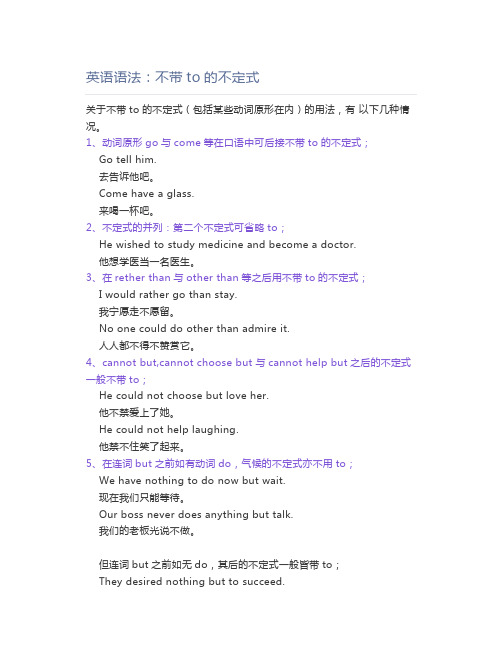
英语语法:不带to的不定式关于不带to的不定式(包括某些动词原形在内)的用法,有以下几种情况。
1、动词原形go与come等在口语中可后接不带to的不定式;Go tell him.去告诉他吧。
Come have a glass.来喝一杯吧。
2、不定式的并列:第二个不定式可省略to;He wished to study medicine and become a doctor.他想学医当一名医生。
3、在rether than与other than等之后用不带to的不定式;I would rather go than stay.我宁愿走不愿留。
No one could do other than admire it.人人都不得不赞赏它。
4、cannot but,cannot choose but与cannot help but之后的不定式一般不带to;He could not choose but love her.他不禁爱上了她。
He could not help laughing.他禁不住笑了起来。
5、在连词but之前如有动词do,气候的不定式亦不用to;We have nothing to do now but wait.现在我们只能等待。
Our boss never does anything but talk.我们的老板光说不做。
但连词but之前如无do,其后的不定式一般皆带to;They desired nothing but to succeed.他们只想成功。
I have no choice but to accept the fact.我只有承认事实。
6、为了避免重复而省去to;I'm really puzzled what to think or say.我真不知道该怎么想怎么说才好。
It's just impossible to see that and not weep.看见那个景象而不哭是不可能的。
解析高考中不带to的动词不定式

解析高考中不带to的动词不定式动词不定式通常是指由to加上动词原形(如to write)所构成的一种非限定动词形式,但在有些情况下to则可以省略。
不定式符号to的省略是高中英语语法教学的一个重要内容,也一直是高考考查热点。
下面笔者结合近年高考及相关试题对此作一归纳总结。
除了我们所熟知的使役动词make、let、have和感官动词see、watch、notice、hear、feel、listen to、look at、observe等后通常用省略to的不定式作宾语补足语外,还有如下结论:一、在had better、would rather、may/might as well、rather than等搭配之后,动词不定式也不带to。
例如:If you'd rather be aloue, we'll all leave here.如果你宁愿独自呆着,那我们都离开这儿。
You might as well go without her.你们还是不带她去为好。
【考例】If you are planning to spend your money having fun this week,better____it-you've got some big bills coming.(2004广东)A. forgetB. forgotC. forgettingD. to forget二、在介词but,except之后,如果其前有动词do的某种形式,其后不定式一般不带to,反之则必须带to,表示“不得不,只能”。
例如:He does nothing but watch TV all day long.他整天除了看电视无所事事。
I have no choice but to accept the fact.我别无选择只有接受这个事实。
【考例】Sandy could do nothing but____to his teacher that be was wrong.(2001上海)A. admitB.admittedC. admittingD. to admit三、以why或why not开头引起的无主语中,动词不定式要省略to。
- 1、下载文档前请自行甄别文档内容的完整性,平台不提供额外的编辑、内容补充、找答案等附加服务。
- 2、"仅部分预览"的文档,不可在线预览部分如存在完整性等问题,可反馈申请退款(可完整预览的文档不适用该条件!)。
- 3、如文档侵犯您的权益,请联系客服反馈,我们会尽快为您处理(人工客服工作时间:9:00-18:30)。
不带to的动词不定式通常有下面十八种情况动词不定式通常带有符号to,叫做带to的动词不定式(infinitive with"to"),动词不定式有时不带符号to,叫做不带to的动词不定式(infinitive without"to")不带to的动词不定式通常有下面十八种情况一、与助动词do连用构成谓语动词的否定、疑问和强调形式。
(1)he does not work in the factory.(2)Does she work here?(3)I did not see her yesterday.(4)Did they take you home?(5)He does look tired.二、与情态动词连用构成复合谓语(1)I can speak English.(3)Dare he swim across the river?(4)We must work,and above all we must believe in ourselves.(5)Could you do something for me?(6)You shall go at once.(7)He might be working in the office now.(9)They should be here by now.(10)If you will go into the fields and turn over a few big stones,you are sure to uncover a city ofant"people".但与情态动词ought(to)连用时通常带to,和used(to)连用时必须带to三、在表示感觉的动词如:see,look.at,watch,hear,listento,feel,notice,observe,perceive(觉察,看见),behold(书面用语“见到”)等后用作宾语补足语的动词不定。
(1)I saw her cross the street.(2)He looked at the children walk up the hill.(3)I watched the boy cross the road.(4)I heard her play the piano.(5)He listend to us talk.(6)I felt the floor move.(7)I didn’t notice you enter.(8)He observed someone open the door.(10)He beheld her go out.但除notice,watch不用被动语态外,上述动词变成被动语态时,其后的动词不定式就不省to(1)She was seen to cross street.(2)She was heard to play the piano.四、使役动词make,let,have,bid, leave(=let)后作宾语补足语的动词不定式不带to(1)You may take a horse to the water,but you can't make him drink.(2)I'll let him do it.(4)Bid him go home.(5)Leave him go.动词have通常不用于被动语态,make和bid可用于被动语态,let偶尔也可用于被动态,用作主语补足语的动词不定式通常带to,但在make和let后有时可以不带to(1)John was made to wash the truck for a week as a punishment.(2)He was made(to) laugh.(3)The child was let(to) do it.五、never与know连用其后作宾语补足语的动词不定式可省to,其时态多为完成时态。
(1)I never knew him act without thinking.(2)I've never known it snow in July before.(3)I had never known her ask for pity before.有时ever与known连用也有上述用法。
(1)Have you ever known me tell a lie?六、在find后作宾语补定语的动词不定式有时可以省to,但如动词为be,那么一般不省to,要省一起省略"to be"(1)We found the farm crops(to) do well.(2)I find the Chinese people to be happy and cheerful.(3)I found this to be true in all the cities.(4)We found him (to be) honest/dishonest.七、在cannot but,cannot help but,can not choose but, hadbetter(best),would(had)rather(sooner)…than…, would assoon…as…后的动词不定一般不带to(1)When the country calls you for help,you cannot but go.(2)He can't help but feel sorry for her.(3)he cannot choose but obey.(4)I had better leave now,or I'll be late.(5)He had best buy it now while it is still available.(6)I would rather go mountain—climbing than just take a walk.(8)I had sooner live on a farm than in the city.(9)He would sooner resign than take part in such dishonest business deeds.(10)I'd rather not tell you.(11)He said he'd sooner die than betray his friend.八、在but(=except),besides,than后的动词不定式一般要带to,但如果其前有作谓语的实义动词do,则不定式不带to(1)The soldier has no choice but to obey.(2)He did not have any choice but to obey.(3)She did nothing but clean the dishes.(4)The children found there was nothing they could do with their money,except spend it onsweets.(5)There seemed nothing else to do but(to)send for a doctor.(but前的实义动词do不作谓语,but后的不定式可带to,也可不带to)(6)He did nothing else than laugh.(7)I could hardly do less than wait.九、不定式作表语时,如主语部分含有实义动词do,且句子的时态为一般现在时或一般过去时(多为is或was),不定式可以带to也可不带to(1)What we must do now is(to) find anther person to help us.(2)All he could do was (to) rush into the room.如句子的动词时态不是一般现在时或一般过去时,作表语的动词不定式一般要带to(1)She knew that all she would have to do would be to stop crying.十、rather than位于句首时,其后用不带to的不定式,但ratherthan在句中时,其后的动词不定式可以带to,也可以不带to(1)Rather than ride on a crowded bus,he always prefers to ride a bicyde.(2)Rather than cause trouble,he left.(3)He prefers to rent a car rather than(to) have one of his own.十一、在动词help后作宾语补足语的动词不定式可以带to,也可以不带,在英国英语中,多用不带to的不定式,但在英国英语中,help+宾语+不定式结构中,用不带to的不定式表示主语直接参与不定式的表示的动作,用带to的不定式表示主语没有直接参与不定式的表示的动作。
(1)He helped me repair the bicycle.(2)He helped me to repair the bicycle.(3)This kind of soap helps us to wash the clothes more easily.(4)The book will help you to study English.但在被动语态中,help后的不定式要带to(1)She was helped to repair her bicycle.在help(to) do sth不定式符号to可省略。
He helped(to) repair the machine.十二、两个或两个以上的动词不定式并列在一起时,第一个不定式带to,后面的不定式一般省去to(1)Her job is to take care of the children and wash clothes.(2)The girl doesn't know how to read and write.但如果是在对照场合,则不省去to(1)It is better to laugh than to cry.(2)The purpose of new technologies is to make life easier,not to make it more difficult.十三、than连接两个动词不定式没有对比关系时,后一个不定式可以省to(1)You might do worse than(to) do as he does.(2)I cannot do better than(to)get away for the few days.下面句子中than连接的不是两个动词不定式than后的动词不定式通常要带to(1)I know better than to believe him.(2)The beaten enemy had no choice than to surrender.下句中的more than(=only)可以看成复合副词,后面的动词不定式不带to(1)I did not more than make a beginning.十四、在why,why not后的不定式不带to(1)Why spend such a lot of money?(2)Why not join us?(3)Why don't you smoke?十五、实义动词dare在现代英语口语中,其所在的否定句或疑问句中,它后的动词不定式可省to,尤其在一般过去时中(1)Does he dare go?(2)We do not dare speak.(3)He did not dare go.(4)Did he dare go?(5)He dared go.(6)Dared he go?(7)He knew she dared not open his mouth.十六、在口语中,特别是在美国,祈使语气谓语动词和构成谓语的不定式go后面的不定式往往不带to(1)Go ask her.(2)I'll go see my brother.这种用法在英国口语中比较少见,一般在动词go后用连词and(1)GO and ask her.(2)I'll go and see my brother.十七、在"will you please…?"和would you please…?句型中,要用不带to的不定式。
